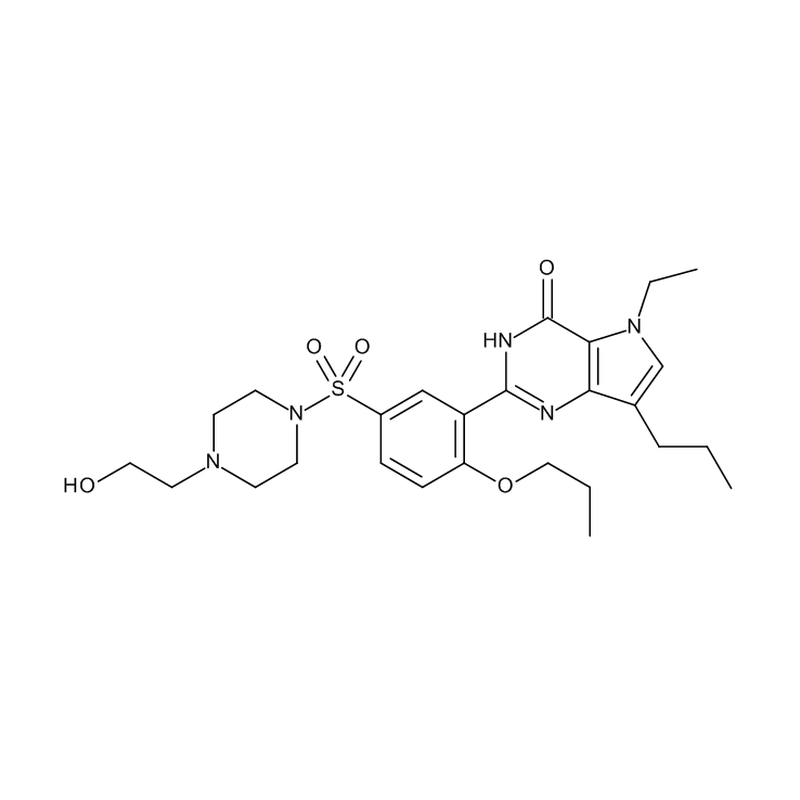产品
编 号:F485197
分子式:C26H37N5O5S
分子量:531.67
分子式:C26H37N5O5S
分子量:531.67
产品类型
规格
价格
是否有货
5mg
询价
询价
10mg
询价
询价
50mg
询价
询价
100mg
询价
询价
结构图

CAS No: 862189-95-5
产品详情
生物活性:
Mirodenafil (SK3530) is an orally active, potent, reversible, and selective phosphodiesterase 5 (PDE5) inhibitor. Mirodenafil is a glucocorticoid receptor (GR) modulator Mirodenafil activates the Wnt/β-catenin signaling pathway by downregulating Dkk1 expression. Mirodenafil can be used for the research of erectile dysfunction (ED), Alzheimer’s disease (AD) and systemic sclerosis (SSc).
体内研究:
Mirodenafil (4 mg/kg, IP, daily for 4 weeks) enhances the cognitive-behavioral performance in transgenic AD mice.Mirodenafil (0-10 mg/kg, Orally, daily for 3 weeks) ameliorates dermal fibrosis in a BLM-induced SSc mouse model by inhibiting the TGF-β signaling pathway, thereby suppressing the expression of collagen and profibrotic genes.Animal Model:APP-C105 transgenic mice (13-month-old, male, n=6)
Dosage:4 mg/kg
Administration:IP, daily for 4 weeks
Result:Improved cognitive function in the APP-C105 AD mice.
Animal Model:Male BALB/c mice (8 weeks old, four groups, n=10/group)
Dosage:0, 5 or 10?mg/kg
Administration:Orally, daily for 3 weeks
Result:Ameliorated dermal fibrosis and downregulated the protein levels of fibrosis markers including COL1A1 and α-SMA in the BLM-induced SSc mouse model. Significantly decreased dermal thickness and collagen content.
体外研究:
Mirodenafil (0-40 μM, 24 h) exerts neuroprotective functions via activating the cGMP/PKG/CREB signaling pathway.Mirodenafil (0-40 μM, 24 h) enhances neuronal survival by protecting the mitochondrial membrane potential and inhibiting apoptosis.Mirodenafil (0-40 μM) inhibits GSK-3β signaling, resulting in reduced tau phosphorylation, decreased Aβ production by inhibiting amyloidogenesis and activating the autophagosomal pathway.Mirodenafil inhibits the transcriptional activity of the glucocorticoid receptor (GR), and inhibits homodimerization of GR in HT-22 cells.Mirodenafil (0-100 μM, 24 h) inhibits TGF-β-induced phosphorylation of Smad2/3 and mRNA expression of the fibrosis marker in fibroblasts.
Mirodenafil (SK3530) is an orally active, potent, reversible, and selective phosphodiesterase 5 (PDE5) inhibitor. Mirodenafil is a glucocorticoid receptor (GR) modulator Mirodenafil activates the Wnt/β-catenin signaling pathway by downregulating Dkk1 expression. Mirodenafil can be used for the research of erectile dysfunction (ED), Alzheimer’s disease (AD) and systemic sclerosis (SSc).
体内研究:
Mirodenafil (4 mg/kg, IP, daily for 4 weeks) enhances the cognitive-behavioral performance in transgenic AD mice.Mirodenafil (0-10 mg/kg, Orally, daily for 3 weeks) ameliorates dermal fibrosis in a BLM-induced SSc mouse model by inhibiting the TGF-β signaling pathway, thereby suppressing the expression of collagen and profibrotic genes.Animal Model:APP-C105 transgenic mice (13-month-old, male, n=6)
Dosage:4 mg/kg
Administration:IP, daily for 4 weeks
Result:Improved cognitive function in the APP-C105 AD mice.
Animal Model:Male BALB/c mice (8 weeks old, four groups, n=10/group)
Dosage:0, 5 or 10?mg/kg
Administration:Orally, daily for 3 weeks
Result:Ameliorated dermal fibrosis and downregulated the protein levels of fibrosis markers including COL1A1 and α-SMA in the BLM-induced SSc mouse model. Significantly decreased dermal thickness and collagen content.
体外研究:
Mirodenafil (0-40 μM, 24 h) exerts neuroprotective functions via activating the cGMP/PKG/CREB signaling pathway.Mirodenafil (0-40 μM, 24 h) enhances neuronal survival by protecting the mitochondrial membrane potential and inhibiting apoptosis.Mirodenafil (0-40 μM) inhibits GSK-3β signaling, resulting in reduced tau phosphorylation, decreased Aβ production by inhibiting amyloidogenesis and activating the autophagosomal pathway.Mirodenafil inhibits the transcriptional activity of the glucocorticoid receptor (GR), and inhibits homodimerization of GR in HT-22 cells.Mirodenafil (0-100 μM, 24 h) inhibits TGF-β-induced phosphorylation of Smad2/3 and mRNA expression of the fibrosis marker in fibroblasts.
产品资料

